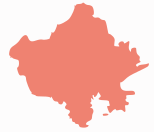Etymology
The district derives its name from its administrative headquarters, the city of Jaipur. The city was established in 1727 by Maharaja Sawai Jai Singh II (1693–1744), the ruler of Amber, and named in his honour. [5] In Sanskrit, the suffix "pur" or "pura" is commonly used to denote a city or town. Thus, the name "Jaipur" translates to "The City of Jai," commemorating its founder, Jai Singh II. [6]
Geography
The district is located between 26°23' and 27°51' north latitude, and 74°55' and 76°50' east longitude. It covers an area of 11,143 square kilometres (4,302 sq mi), accounting for approximately 3.26% of the state's total area, and ranks 9th in size among the districts of the state. [a] [4] The district stretches about 180 kilometres (110 mi) from east to west, while its north to south length is approximately 110 kilometres (68 mi). It shares its northern boundary with the Sikar district and the state of Haryana. Towards the south, the district is bordered by Tonk district. On the eastern side, it is surrounded by Alwar, Dausa, and Sawai Madhopur districts, while to the west, it is flanked by Nagaur and Ajmer districts. [7]
The district is located on the eastern border of the Thar Desert and is largely covered with a thick layer of soil and alluvial deposits. The district is surrounded by the Aravali mountain range on three sides. [7] Towards the north and east, the region is bordered by hill ranges and several isolated peaks, which rise about 200 metres (660 ft) above the surrounding plains. These hills form a part of the Aravali mountain range. At different locations within the district, these ranges are known by various local names. The hills originate from the area around Sambhar Lake and continue into Jhunjhunu district. In Jaipur tehsil, these are commonly called Puranaghat and Nahargarh. In the tehsils of Kotputli, Bairath, and Jamwa Ramgarh, the hills are referred to by names such as Ada Doongar, Chapa, Khan Rahori, Khan Dogota, Jaroonda, Khan Raipur, and Khan Badri. Additionally, the Torawati hills are situated to the west of the Sabi and Banganga rivers. [4]
Demographics
Historical population| Year | | |
|---|
| 1901 | 944,116 | — |
|---|
| 1911 | 889,399 | −0.60% |
|---|
| 1921 | 729,878 | −1.96% |
|---|
| 1931 | 813,631 | +1.09% |
|---|
| 1941 | 926,153 | +1.30% |
|---|
| 1951 | 1,186,745 | +2.51% |
|---|
| 1961 | 1,508,009 | +2.42% |
|---|
| 1971 | 1,993,463 | +2.83% |
|---|
| 1981 | 2,802,414 | +3.46% |
|---|
| 1991 | 3,887,895 | +3.33% |
|---|
| 2001 | 5,251,071 | +3.05% |
|---|
| 2011 | 6,626,178 | +2.35% |
|---|
| source: [8] |
According to the 2011 census Jaipur district has a population of 6,626,178, [4] roughly equal to the nation of Libya [10] or the US state of Washington. [11] This gives it a ranking of 10th in India (out of a total of 640). [4] The district has a population density of 598 inhabitants per square kilometre (1,550/sq mi). [4] Its population growth rate over the decade 2001-2011 was 26.91%. [4] Jaipur has a sex ratio of 909 females for every 1000 males, [4] and a literacy rate of 76.44%. 52.40% of the population lives in urban areas. Scheduled Castes and Scheduled Tribes make up 15.14% and 7.97% of the population respectively. [4]
This page is based on this
Wikipedia article Text is available under the
CC BY-SA 4.0 license; additional terms may apply.
Images, videos and audio are available under their respective licenses.






